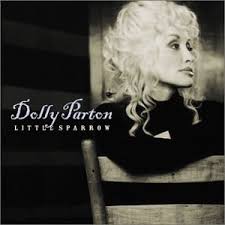 In the collection of “chick flicks” TBS broadcast on Super Bowl Sunday, one film stood out. It was slightly older, a little bit wiser, and offered charming performances by Shirley MacLaine, Olympia Dukakis, Julia Roberts and a virtually unrecognizable Daryl Hannah. But the warm heart of Steel Magnolias was provided by Dolly Parton, who has a way of lighting up the screen. Even for an old cynic like myself, Dolly’s infectious smile and heart-warming giggle was contagious. She has a way of connecting with the audience that is real, whether on film, on stage or on record.Two years ago, when she was unceremoniously dropped by her record company, Dolly decided to return to her roots. She moved to the independent Sugar Hill label and presented her best album in a decade, The Grass Is Blue. Her take on bluegrass music was extraordinary and won acclaim and awards. Now she is back with the sequel, Little Sparrow, and she offers up more bluegrass done the Parton way … with a bit of a twist.
In the collection of “chick flicks” TBS broadcast on Super Bowl Sunday, one film stood out. It was slightly older, a little bit wiser, and offered charming performances by Shirley MacLaine, Olympia Dukakis, Julia Roberts and a virtually unrecognizable Daryl Hannah. But the warm heart of Steel Magnolias was provided by Dolly Parton, who has a way of lighting up the screen. Even for an old cynic like myself, Dolly’s infectious smile and heart-warming giggle was contagious. She has a way of connecting with the audience that is real, whether on film, on stage or on record.Two years ago, when she was unceremoniously dropped by her record company, Dolly decided to return to her roots. She moved to the independent Sugar Hill label and presented her best album in a decade, The Grass Is Blue. Her take on bluegrass music was extraordinary and won acclaim and awards. Now she is back with the sequel, Little Sparrow, and she offers up more bluegrass done the Parton way … with a bit of a twist.
Some of the musicians playing with Dolly have remained constant, others have changed, but the quality of picking and singing has stayed high. Alison Krauss, Dan Tyminski (who is the singing voice of George Clooney in O Brother Where Art Thou), Rhonda Vincent and others provide background voices, and the group singing is tremendous. Dolly’s lead vocals show her range and expression, and it’s great to hear her singing something other than country pop!
The great Sam Bush is gone this time, but the mandolin chair is filled by upcoming star Chris Thile. He is going to be a monster. Whether comping on the upbeat or filling spaces with a flurry of notes (as on “I Don’t Believe You’ve Met My Baby”), he is unobtrusive yet essential. This is the case with each member of a real bluegrass band. Much is made of bluegrass improvisation (and there’s plenty of that here), but the music is carefully constructed and rehearsed, as much an ensemble piece as Duke Ellington’s best music was. Bryan Sutton, the guitar player, really caught my ear on The Grass Is Blue, and he shines again on Little Sparrow, providing a solid rhythmic foundation for the invention of his band-mates. Jerry Douglas’ resophonic solos soar, and the fiddle breaks by Stuart Duncan swoop in and out. This is exciting music.
The songs range from gospel hymns to country classics, from Dolly originals to Cole Porter! Each song, whether swinging or melancholic, utilizes the band well but ultimately centers on the crystal clear voice of Dolly Parton. Her Tennessee twang is strongly evident, perhaps exaggerated, but her pitch is unfailing, and her emotion is beautifully controlled. She makes Steve Young’s anthemic “Seven Bridges Road” her own, as it begins a capella and then takes off at a rolling gait, featuring Stuart Duncan’s fiddle, Jim Mills’ banjo and the strong bass of Barry Bales. The way she sells the surprise punch line of “I Don’t Believe You’ve Met My Baby” is sure to bring a smile to your face.
Dolly’s originals take several shapes. From the ballad “My Blue Tears” to the country song “Bluer Pastures,” she shows herself to be a master of forms. Most impressive is the traditional-sounding “Down From Dover.” I was convinced that this was an “olde” English ballad, but there, in the liner notes … it says Dolly Parton. Backing vocals by Maura O’Connell help to create the folk sound.
Little Sparrow is not the “pure” bluegrass that Dolly did on The Grass Is Blue, but it is a logical development from there. Adding folk and an Irish angle (provided by special guests Altan), Miss Parton is not content to rest on her laurels. She is moving toward the future, with the past clearly in sight. I for one can’t wait to hear where she goes next!
(Sugar Hill, 2001)
